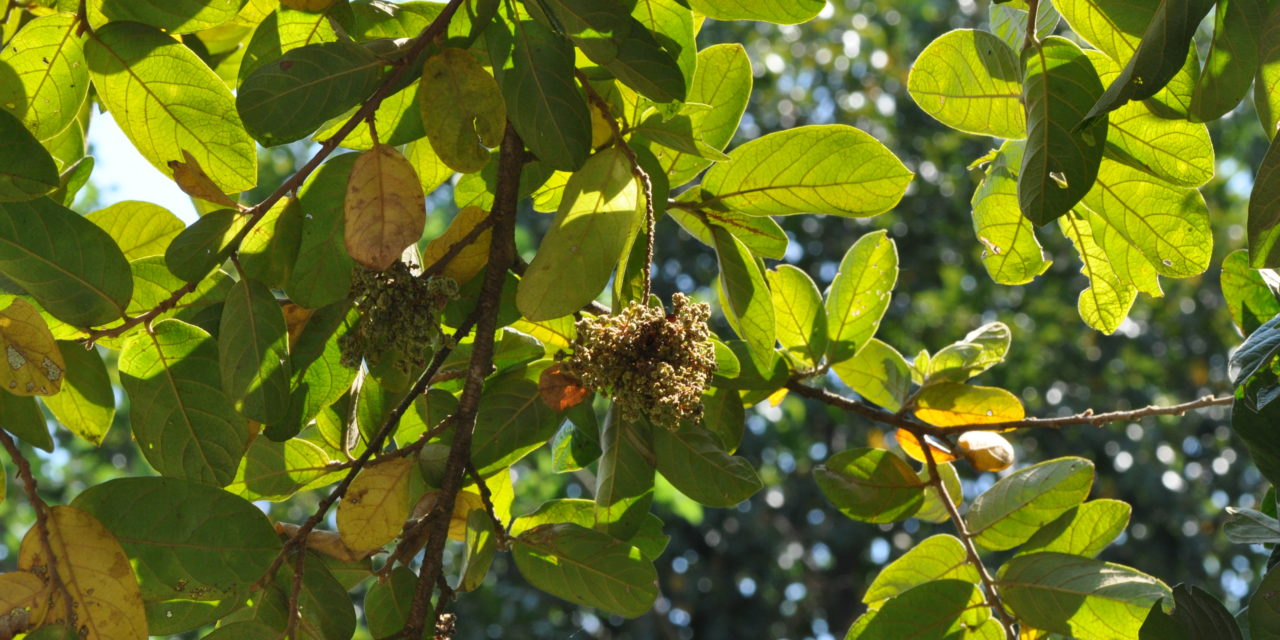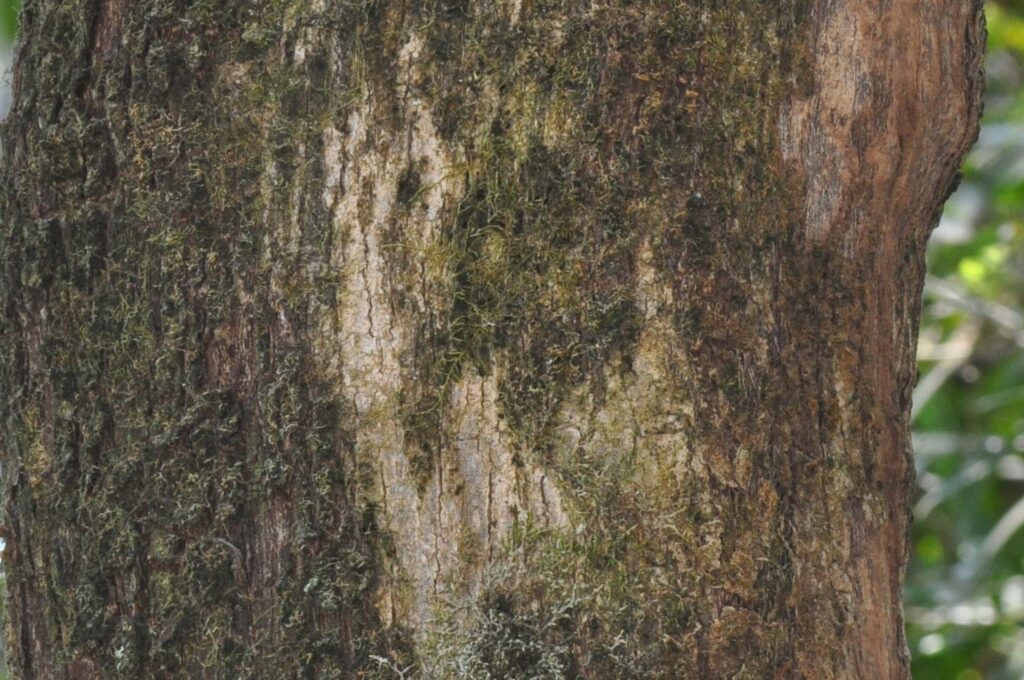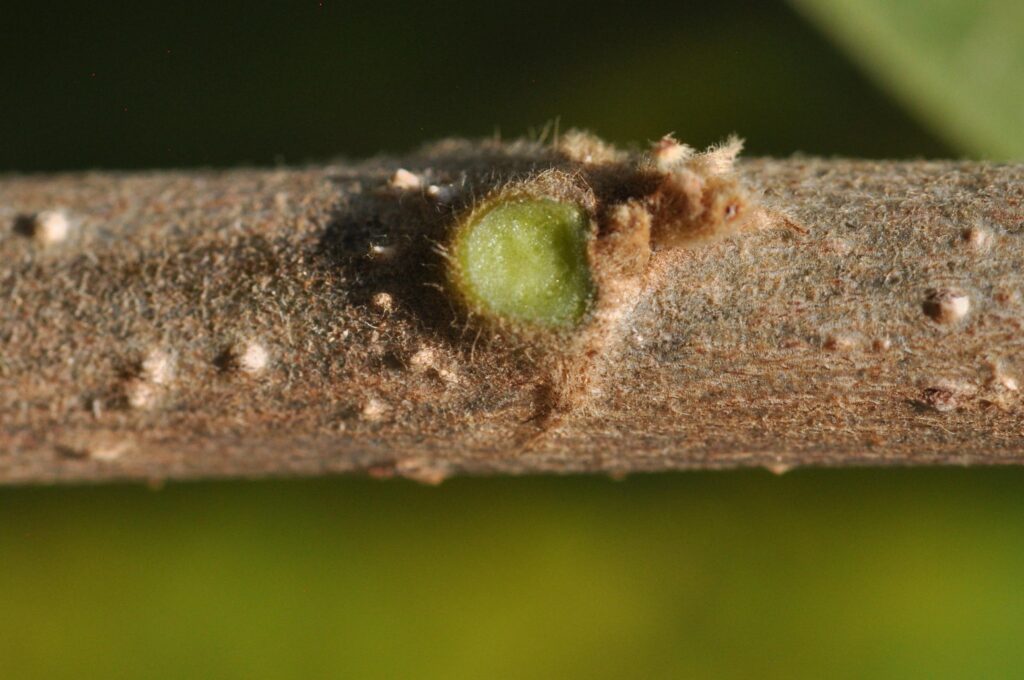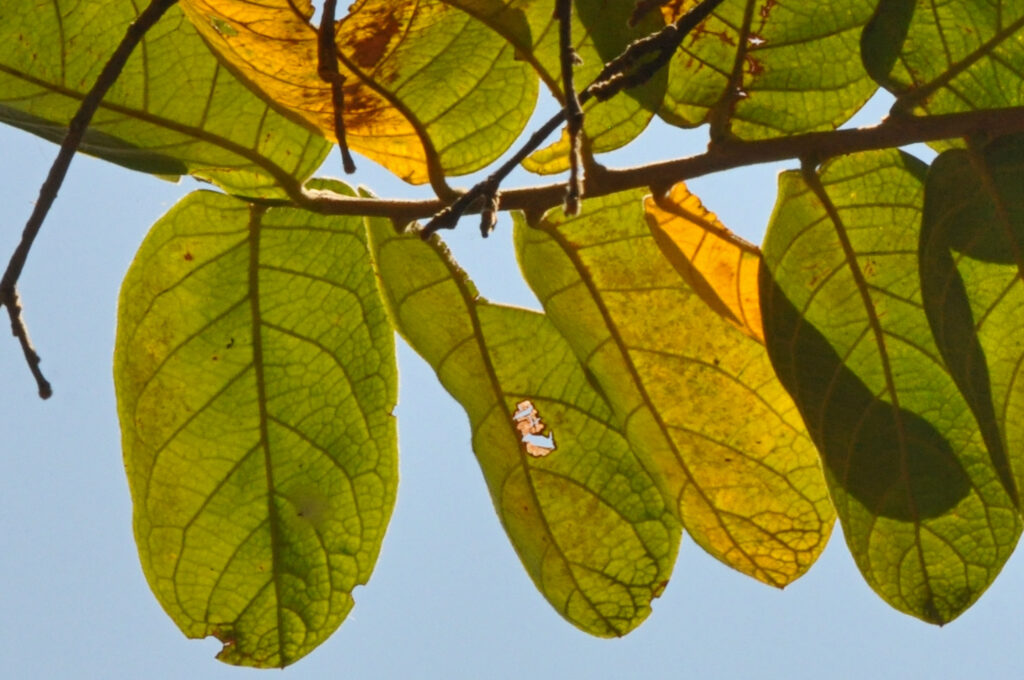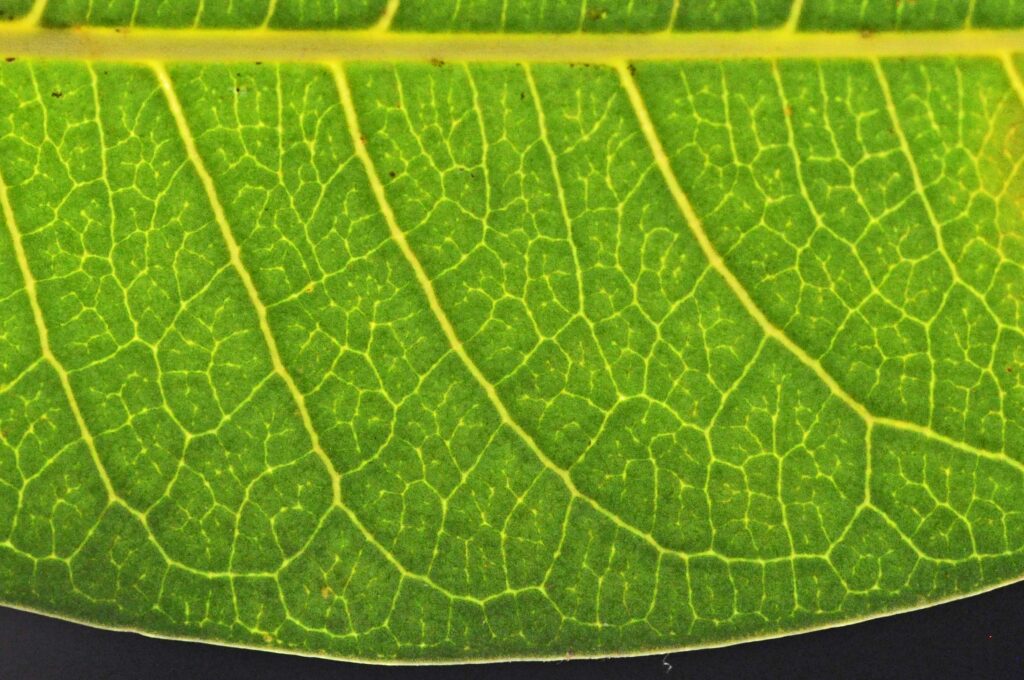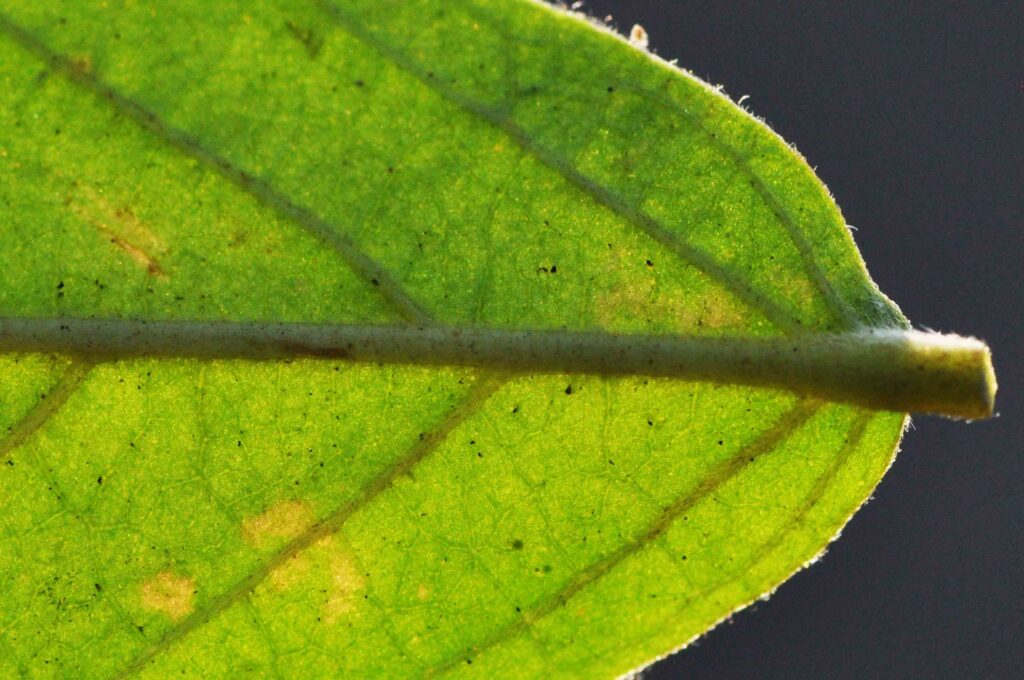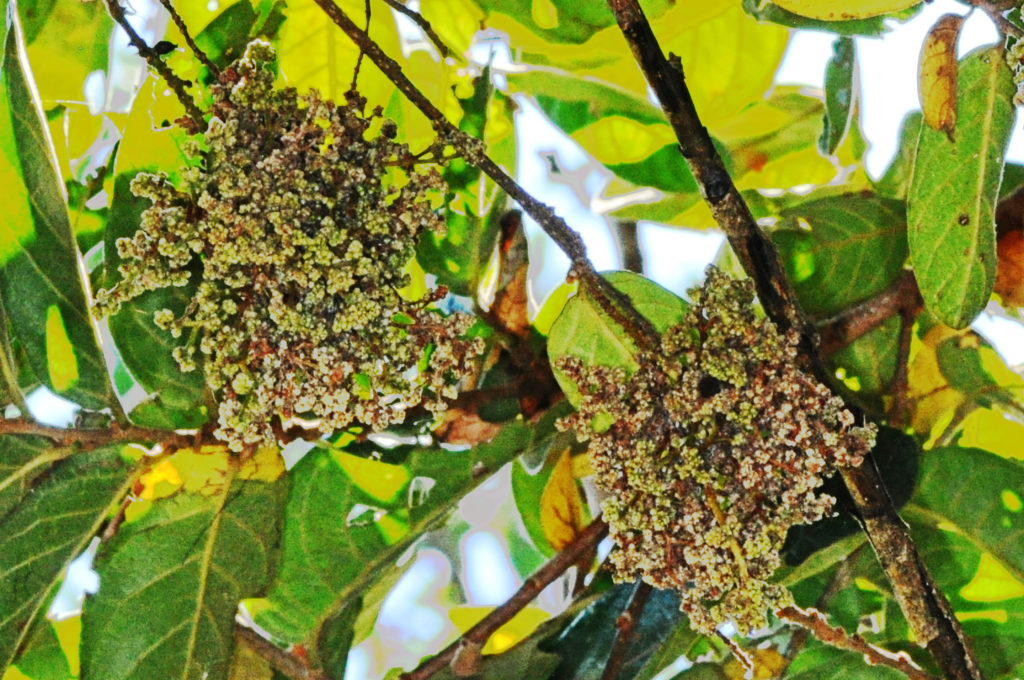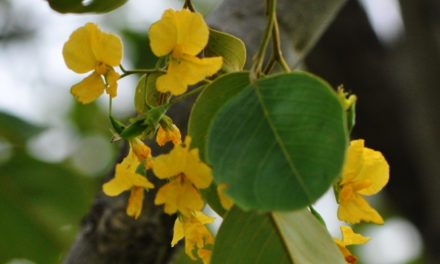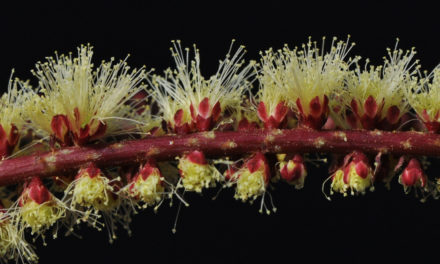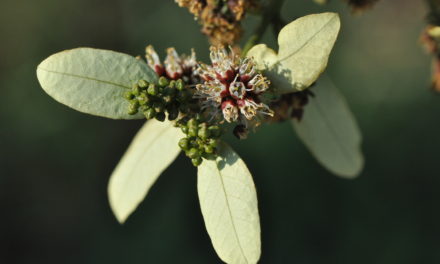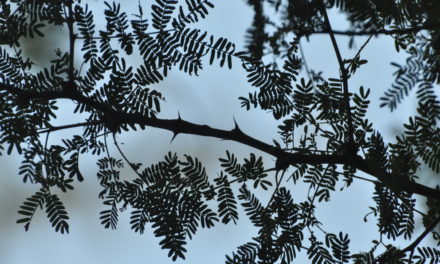Antidesma venosum
General Info – summary
This dioecious Tree with its greyish brown, rough, flaky bark is usually up to 8m high or is a shrub. The large alternate Leaves are simple, entire & with large stipules. 2 pairs of veins arise close to the base. The attractive, scented Flowers lack petals. Yellow males are in catkin-like spikes. Reddish females are in racemes, with a superior ovary. The colourful, edible and fleshy Fruit is a drupe like with 1 flat seed.
Description.
Previous Names: Antidesma bifrons, Antidesma biovinianum.
SA Tree No. 318.
Common names: (Afr) Tosselbessie, Voëlsitboom. (Eng) Tassel-berry. (isiXhosa) Umtyongi. (isiZulu) Isangowane, Isibhangamlotha (makes ash), isiqhuthwane, Isiqutwane, Umhlabahlungulu, Umhlalanyoni. (Northern Sotho) Modulane. (Setswana) Kgôbê-tsabadisana, Moingwe, Segagama. (siSwati) inhlalamahubulu, Umhlalanyoni, Umhlala-mahuhulu, Umhlongi. (Tshivenda) Mufhala-khwali, Mupala-khwali. (Xitsonga) Anshongi, Anwangati.
Family Phyllanthaceae. This family is most noticeable in the tropics (future changes are probable). In this diverse family, some genera are poorly defined. Latex and Spines are usually absent. This is diagnostic and excludes them from Euphorbiaceae. There are about 50+ genera and 2 000 species in this family. They are most numerous in the tropics and most members are trees. Leaves are usually simple, alternate and petiolate. Leaf margins are usually entire and, leaves are present in most species. The actinomorphic Flowers are usually unisexual and may be monoecious or dioecious. The superior Ovary has 2 ovules in each locule. The Fruit is a berry, drupe or schizocarp. Local genera containing trees on this website include Antidesma, Bridelia (about 50 species), Cleistanthus (about 140 species), and Heywoodia (1 species).
Name derivation: Antidesma – poison against (snakes), or it may refer to the banded bark used for rope. venosum – with distinctive (leaf) veins. Globally there are 100 species of the genus Antidesma and 2 in Southern Africa.
Conservation: National Status: L C. (least concern). Assessed: Raimondo et al. (2009).
Tree
This small, usually graceful Tree is 4-9m high with a spread of up to 4m, or it may remain a shrub. In the Ngoye Forest Preserve in KwaZulu-Natal (14km inland from Mtunzini), the tree reaches 15m high. The Crown may be rounded and spreading or slender. The Bark (photo 777) is greyish brown (lighter in sunny areas), smooth or rough and flaky. The Stem (or trunk is main axis of the plant, the leaf and flower bearing as distinguished from the root-bearing axis) is usually twisted, and branches occur low-down. Young Twigs (1-year-old current branch segments – photo 83) are covered with red hairs and have pale grey Lenticels (usually raised corky oval or elongated area on the plant that allows the uncontrolled interchange of gases with the environment – photo 83). In this photo a greenish leaf scar is visible.
- 777. 2014/09/16. Lowveld NBG. Photo: David Becking.
- 777. 2014/09/16. Lowveld NBG. Photo: David Becking.
Leaves
The untoothed alternate and 2 ranked Leaves are ovate, elliptic, lanceolate or oblong (photo 779) and simple (have a single blade which may have incisions that are not deep enough to divide the leaf into leaflets). This semi-deciduous plant has leaves that are glandless and often large – up to 15 x 10cm. They usually turn yellowish before falling. The leathery Blade is usually shiny bright green above and here the Veins are sunken. It is paler green below and up to 7 pairs of prominent hairy side veins are visible (photo 779). Leaf details become more distinctive when part of an individual leaf is examined against the sun (photo 84). In this photo the veins branch and loop together before reaching the Margin. The margins are entire (with a continuous margin, not in any way indented – photos 84). The Apex may be rounded, or it may taper – in which case a drip tip may be present. The Base is rounded (photo 130) to cordate (heart shaped – photo 779). Apart from the midrib (the main rib of a leaf or leaf-like part, a continuation of the petiole), at least 2 other pairs of veins start near the hairy leaf base (photo 130). The short – up to 1cm long Petiole (leaf stalk) is swollen, hairy (photo 130) and grooved on upper surface. Hairy Stipules (basal appendage of the petiole) are large, conspicuous, have tapering tips and are nearly persistent.
- 779. 2014/09/16. Lowveld NBG. Photo: David Becking.
- 84. 2019/08/12. Skukuza KNP Photo: David Becking.
- 130. 2019/08/12. Skukuza KNP Photo: David Becking.
Flowers
The many attractive, unpleasantly or honey scented Flowers develop at the ends of newly grown twigs (1-year-old current branch segments) are dioecious (unisexual floral structures with male and female parts on separate plants). The Calyx is small, membranous and imbricate (having regularly arranged, overlapping edges). Petals are absent. The small, pale yellow to white Male Flowers are in drooping, long, thin catkin like Spikes (simple indeterminate inflorescence with sessile flowers on a single unbranched axis, opening in succession towards the apex) that are up to 8cm long. Here Stamens are present, but the rudimentary Ovary lacks a Pistil. The reddish Female Flowers are in thin, shorter Racemes (a simple elongated inflorescence with stalked flowers that open in succession towards the apex). The Disc (a more or less fleshy or elevated development of the receptacle) is annular (in a ring or arranged in a circle) surrounding the base of the ovary. The superior Ovary usually has a single locule with 2 ovules. The Styles are usually bilobed. (Roughly Oct-Jan).
- 780. 2014/09/16. Lowveld NBG. Photo: David Becking.
Fruit
Each Fruit resembles a drupe up to 8 x 5mm, that develops in a short pendulous Spike. It changes from white to red and finally to purplish black when mature. The remains of the style are still visible at the apex of each fruit. All the different aged fruits have different attractive colours ranging from green, white, purple and finally purple black. They are often simultaneously visible and last up to a month. This varied aging process aids effective seed dispersal. By abortion, each fruit contains only a single Seed. Seeds are flat with broad, flat cotyledons (seed leaf; primary leaf or leaves in the embryo). The albumen (starchy or other nutritive material surrounding the embryo) is fleshy. (Jan-May but may occur before or after this time).
Distribution & Ecology
These plants can be Found in wooded grasslands, at medium to low altitude in a seasonally dry tropical biome. Further north, where it is warmer, the frost sensitive plants develop at higher altitudes and further from the sea – up to an altitude of 1 900m. These plants occur mainly in the open in eastern South Africa: Eastern Cape near Port St Johns, KwaZulu-Natal – especially near the coast, Limpopo, Northern Province, Mpumalanga e.g., near Punda Maria and the Lebombo mountains (including Swaziland). They are widespread in Mozambique, Botswana, northern Namibia and northwards to Sudan. They also grow in southern China and Indochina. Trees grow close to rivers, in forest margins, sand forests, termite mounds, mixed deciduous woodland and open savannah. Game, including kudu and impala browse the Leaves. Monkeys, baboons and birds, (including bulbuls, mousebirds, barbets, white-eyes and thrushes) consume the fruit. Insects may parasitize the flowers causing them to become distorted and tangled with sterile growth.
Ethnobotany
Apart from the possible smell of the flowers, this tree would be worth planting in a sunny area without excess shade. This usually small tree is slow growing and propagation by seeds is possible. It is important to remove the flesh surrounding the seeds before planting. This tree is frost sensitive. The sweet attractive Fruit is edible and has a sweet flavour similar to that of a mulberry – opinions differ on the taste but it is consumed by people, monkeys and baboons. The fruit can produce a reddish-purple dye. The small, hard, dense, fine Wood has a yellow sapwood and a dark heartwood. It is useful for fishing rods, hut building and fuel. The non-aggressive Roots may be toxic. Local medicine makes use of bark, roots and leaves. This slow growing plant is a good garden tree but both male and female plants are required to produce the attractive fruit. The best way to achieve this is by planting cuttings from the separate male and female plants. This plant may be used as a street tree. Pruning can be used to induce a taller, upright tree.
References
Archer, R.H. & Victor, J.E. 2005. Antidesma venosum E.Mey. ex Tul. National Assessment: Red List of South African Plants version . Accessed on 2025/02/26.
.
Boon, R. 2010. Pooley’s Trees of eastern South Africa. Flora and Fauna Publications Trust, Durban.
Burrows, J.E., Burrows, S.M., Lotter, M.C. & Schmidt, E. 2018. Trees and Shrubs Mozambique. Publishing Print Matters (Pty) Ltd. Noordhoek, Cape Town.
Coates Palgrave, M. 2002. Keith Coates Palgrave Trees of Southern Africa, edn 3. Struik, Cape Town.
Ginn, P.J. McIlleron, W.G. Milstein, S. 1989. The Complete Book of Southern African Birds. Struik Publishers (PTY) LTD. Third impression 1991.
KEW
Lawrence, G. H. M, 1951. Taxonomy of Vascular Plants. The Macmillan Company, New York. Tenth Printing 1965.
Palmer, E. & Pitman, N. 1972. Trees of southern Africa. Balkema, Amsterdam, Cape Town.
Schmidt, S. Lotter, M. & McCleland, W. 2002. Trees and Shrubs of Mpumalanga and the Kruger National Park. Jacana, Johannesburg.
van Wyk, B. & van Wyk, P. 1997 Field guide to Trees of Southern Africa. Struik, Cape Town.
http://www.plantzafrica.com/plantab/antidesmavenosum.htm
https://en.wikipedia.org/wiki/Antidesma
http://www.zimbabweflora.co.zw/speciesdata/species.php?species_id=134560
http://www.floratrust.co.za/blog/Antidesma-venosum-Tassel-berry/
https://www.theplantlibrary.co.za/Plants/Antidesma-venosum
https://en.wikipedia.org/wiki/Phyllanthaceae

